Since we got the floor down six weeks ago, we have used the kitchen almost as if it were finished–even though it’s still lacking countertops, the permanent sink, and a refrigerator. I moved the base cabinets I’d purchased in June into the kitchen and put the everyday utensils and dishes into them. Although I rationalized my using the cabinets before they were installed as a test run for cabinet configuration, I did it primarily to regain a sense of control, a sense of living normally, like other Americans without pots and pans in the living room. Having most things hidden in kitchen drawers was both convenient and soothing.
Dateline: 2006-11-18
I was not looking forward to another day with our kitchen goods piled in the living room.
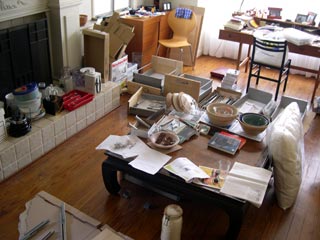
So it was with no little trepidation and a great deal of reluctance that I faced this weekend: putting the cabinets up permanently. While the end result is definitely a good thing, I anticipated that the process was going to be trying. There were too many variables, too many prerequisites. All Friday I was reviewing the order of work and coming up with circular dependencies. This was definitely a weekend project (or a 3-day project if you factor in Friday’s fretting.) When I joined Stacy, Trevor, and AJM for dinner and a movie, my mood was generally acknowledged as sullen. Throughout the weekend it has progressed through cranky and grumpy before settling on irritable.
If I’ve given you the impression that AJM and I always work as a finely-oiled team (as we used to joke about our original software development group), let me disillusion you. Given our different skills and strengths we can usually divide project tasks harmoniously. But in a situation such as this where neither of us has prior experience and no clear process is in view, the fact that we’re both used to being project architect and team leader results in a lot of orders naturally given and no subordinates to take them. On top of that, we’re both intuitives. When our minds are leaping forward together on the same track, this is a fine thing. But when we’re brainstorming, we rely too much on assuming the other person knows what we’re thinking (each of us, of course, knowing that our plan is obviously logical and correct) and too little on explaining our strategies.
Installing the cabinets is a precondition to installing the countertop which is a precondition to installing the sink. Years ago, AJM had planned to make the cabinets by hand. He bought many woodworking tools and practiced first building an entertainment center and set of lawyers bookcases. In the process woodworking lost its charm for AJM (if a project doesn’t require a new tool it’s not interesting) and even as early in the project as last January, we decided to buy the cabinets instead. AJM and I drove to IKEA Houston in January to pick them out and I drove there alone in June to buy them. If I never drive to Houston again in my life, I will die without regret.
From the beginning I had decided I wanted the cabinets to look free-standing, without toe-kicks. The toe-kicks had been too short in the old kitchen. You couldn’t get the vacumn cleaner or a handled sponge mop under the cabinets to clean. Also I didn’t want to install the base cabinets and then have to cut the bamboo flooring around them to fit (which is the usual order of work). I liked the clean 1950s Skandanavian style where the furniture is attached to the wall and the floor is an unbroken plane. This makes a small room look larger and airy.
I also wanted the cabinets to be taller than standard. Although I’m short, the original 1940s built base cabinets were built for someone even shorter. I couldn’t work at them for long without my back aching. Following the advice on ergonomics in The Motion Minded Kitchen we decided to have the countertops at 38 inches rather than 35 inches. The standard height cabinets on the right; the custom height with stainless steel legs on the left.
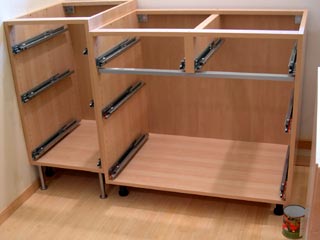
Customizing the cabinet height necessitated buying special legs from IKEA. And although it seemed like a sensible online purchase, no item related to kitchen cabinetry is available online. What we’ve been waiting on these last six weeks is for IKEA Round Rock to open, which it did this November 15th.
Day 1: Saturday, November 18, 2006
After moving all the drawers and their contents into the living room, we begin the project Saturday morning by watching the DVD instructions that IKEA ships. Seems simple enough in the movie where the room is empty and true to square.
We disagree whether the cabinets should have back legs. In my design, the cabinets look free-standing like furniture, not built-ins. The legs are adjustable for the still present anomalies in the levelness of the floor. AJM wants the back to rest on a level board making the back legs redundant. AJM’s argument about structural integrity and ease of installation and levelling are convincing. We screw a 7 foot length of MDF to the wall after much niggling over the reading of the level.
I had bought four legs for each cabinet. IKEA suggests that cabinets next to each other share a leg. We went for a third option. Since the cabinets are either 18 inches or 36 inches wide, we put a leg every 18 inches.
Next problem. Will the taller cabinets mean that the u-bend in the drain won’t fit? Maybe. Whew! Just barely fits.
Next problem. How do we raise the new dishwasher up to the non-standard height of the base cabinets? Good question. We don’t know. Moving on.
Next problem. What kind of holes are we going to have to cut in the side of the sink’s base cabinet to allow the hot water and drain pipes to be plumbed to the dishwasher? Spend some time reading the dishwasher installation manual and continue mulling.
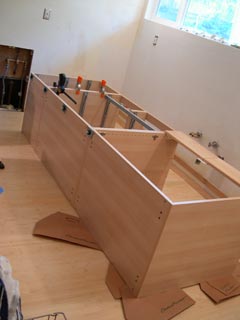
Next problem. How do we lift all 7 feet of cabinetry and the sink cabinet over the pipes coming out of the wall? Normally you rest the back of the cabinet on a level board, lift the front of the cabinet and snap the plastic legs into pre-drilled holes. Our special legs have to be screwed on and shared across cabinets. The three cabinets are too heavy for us to lift as a unit. We do the first two and deal with the sink cabinet separately.
Next problem. How are we going to fit the plumbing into the back of the cabinets? When the wall was down to its studs, we spent several hundred dollars having our plumber install new plumbing for the outdoor washing machine and refrigerator ice-maker, and fit shutoff valves for the kitchen sink and dishwasher. The IKEA cabinets have a decorative backpiece which our old cabinets didn’t. In order to fit over the pipes we have to cut holes in the backpiece. Ideally, the holes should be small and the shutoff valves put on afterward. There is no way I’m removing those soldered shutoff valves.
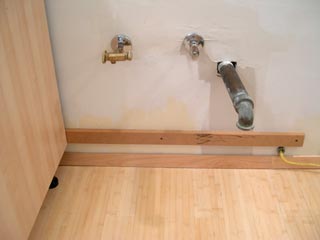
2006-11-18. I’m not touching the newly installed plumbing. We’ll have to fit around it.
We agree to be resigned to rather large holes in the back of the cabinet around the pipes. I suggest that we make a pattern out of cardboard to determine the alignment of the three pipes and practice on it first. AJM does this while I’m out in the garden and when I’ve returned he has already cut three holes into the cabinet. They are beautifully aligned in relation with each other. They are also 2 inches too low. We now have much bigger holes fitting around the pipes. No one will ever see those, right? Damn. I knew I should have sanded and painted that drywall around the pipes–even though I thought the cabinets would hide the mess.
We go off to Lowe’s for some drywall anchors and call it a day. The cabinets are roughed in but now, four days before Thanksgiving, we don’t have a sink.
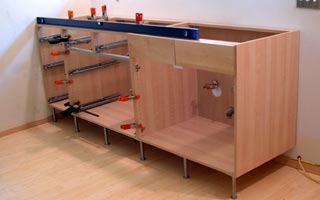
Day 2: Sunday, November 19, 2006
Sunday morning progresses much more smoothly. AJM screws the drywall anchors into the back wall to secure the tops of the cabinets. We drill holes through the sides of each cabinet and use the hardware provided by IKEA to bolt them together. We fuss with the levelling and adjust the legs and tighten up everything. As soon as AJM gives me the OK, I start moving drawers and stuff out of the living room back into the kitchen. (However, it still looks like the first photo above.)
I have a date with The Transplantable Rose and the other Austin garden bloggers so the project stops for the afternoon. When I return, AJM has put legs on the last cabinet in the run–the one that stands alone between the dishwasher and the refrigerator. He decided that this one needs all four legs.
We agree that the mop sink can go in front of the sink cabinet for now. We need to buy longer braided water supply lines to hook up the water again. AJM is in the middle of cooking dinner and we decide it’s too late for another trek to Lowe’s. He does hook up the drain with existing pieces of PVC pipe we have on hand so I’m able to do some dishes by carrying water in from the bathroom.
We still haven’t settled on a strategy for fitting the dishwasher into place. And before we can contact the countertop people I still have to assemble the other two small pantry cabinets. It’s late and we opt to continue later.
Here we are almost back to our standard of normal. The problematic dishwasher awaits installation.
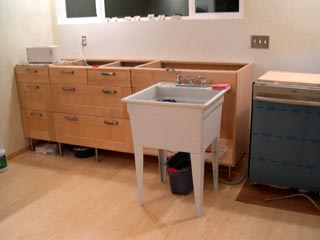
Well, we have come a long way even if we still have a long way to go. During weekends like this, I have to keep reminding myself that it was horrible before. I hated it. And now I’m so near loving it.
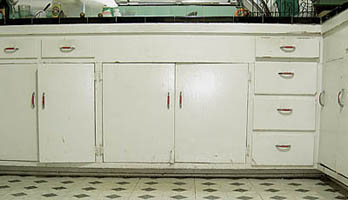
Aaah! I get heart palpitations just reading about this. B and I would be staring at each other like rabid cows over a battlefield by this point.
* In situations such as this, the differences of his P-type and my J-type are really apparent. I want to beta every strategy. I want a walkthrough. I’ve long since stopped believing that we understand each other’s words. I want to block out the steps we’ve supposedly agreed on to discover any problem areas. AJM just wants to jump in and do it. My hovering about asking questions like, “And then we’re going to do this? And what about doing that?” drives him bonkers. Especially when I yell in panic, “Wait! Wait! Wait!” –mss
Excuse me. You said “outdoor washing machine.” Is this your clothes washer? Some other washing machine? Whatever it is, you don’t have to drain it for winter so the pipes don’t freeze and burst?
Yes our clothes washing machine and dryer are on the back porch. They don’t freeze. I hadn’t even thought of that. The pipes do have insulation around them. Austin occasionally gets cold enough for pipes to burst–but the weatherman advises us to make sure pipes are covered and leave them dripping. Really cold weather (a freakish dip into the 20s) rarely lasts for more than a day or two.
One of the infrastructure improvements of this project was to wire and plumb the washing machine/dryer in the rebuilt wall. Originally the conduit and pipes were attached to the outside of the house. –mss
Oh, M! When you came into the kitchen yesterday you must have felt as if you were transported into your own “before” photo! Your old off-white ones sure look like my cabinets, don’t they? I’m okay with my doors, but hate the fake mediterranean handles.
After reading about the overly large openings for plumbing, I checked my kitchen sink, and guess what? There is no back wall on that particular cabinet (the others do have backs), just the drywall with the pipes emerging.
Your new, sleek wooden ones suit you much better, I think, and in tandem with the bamboo floor will manage to look both serene and voluptuous at the same time, severe in line but lavish in material.
The comments are sort of folded on my screen, but are mostly readable–and familiar–I’m still reading the instructions and Philo has it half-assembled… he claims that it’s more fun that way. And we also make mistakes because we are so sure we understand each other that we leave out critical information bits.
Reading your saga is fun–hope you soon have your dream kitchen all together.
Annie in Austin
I thought your kitchen looked fantastic. I need to post a better close-up of the old cabinets to illustate the difference. They were hand built out of plywood and painted white with a lead-based paint. Over the last 60 years they had cracked and chipped. Most of the cabinet door did not hand well and would not remain closed. (On the worse ones we used magnets to hold them shut.) Here are some more photos showing how out of level the cabinets were and how one door was cut as a trapezoid instead of a rectangle.
I like your description of my new look. We wanted to look modern but not cold or sterile. So there is a mix of stainless steel with warmer woods and bamboo. Most of the stainless steel appliances have curves (except for the new fridge)…voluptuous is a good image. — mss
I like the look of the free-standing cabinet. Don’t remember ever seeing those before. I am afraid it would be a cleaning problem for us though.
I liked the mid-century Modern look the cabinets have without the baseboards. They aren’t actually free-standing, though, as they are bolted to the wall. When the counters are on they will be built-ins, just without a kickboard. — mss